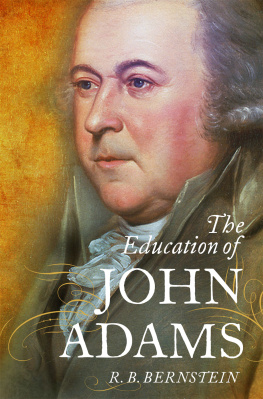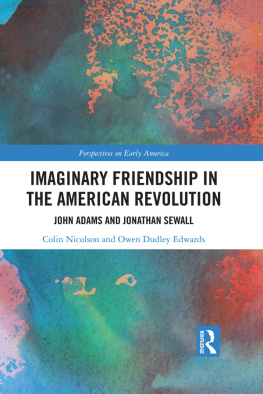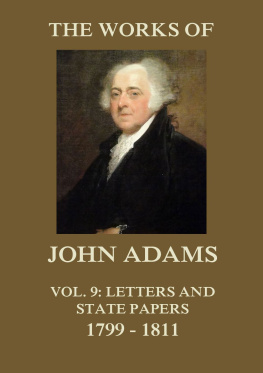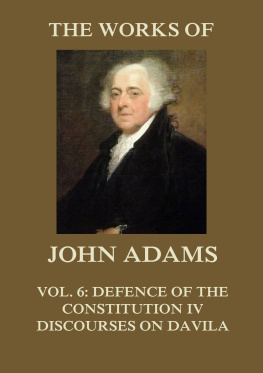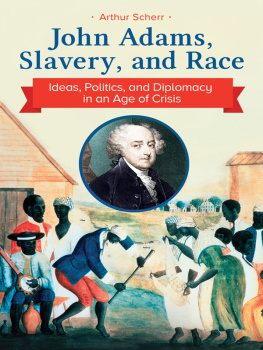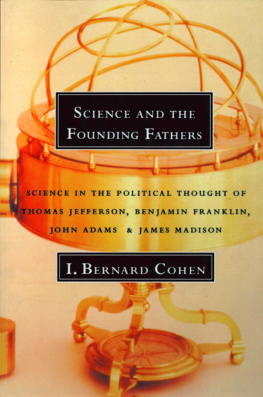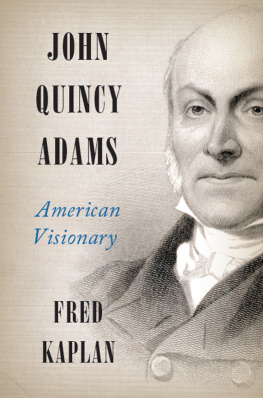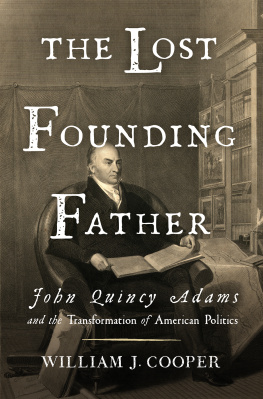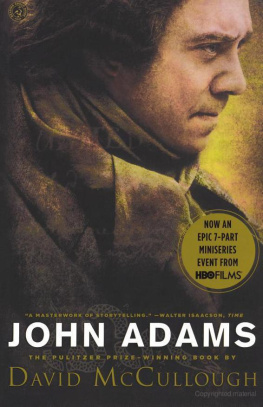THE EDUCATION OF JOHN ADAMS

Oxford University Press is a department of the University of Oxford. It furthers the Universitys objective of excellence in research, scholarship, and education by publishing worldwide. Oxford is a registered trade mark of Oxford University Press in the UK and certain other countries.
Published in the United States of America by Oxford University Press
198 Madison Avenue, New York, NY 10016, United States of America.
Oxford University Press 2020
All rights reserved. No part of this publication may be reproduced, stored in a retrieval system, or transmitted, in any form or by any means, without the prior permission in writing of Oxford University Press, or as expressly permitted by law, by license, or under terms agreed with the appropriate reproduction rights organization. Inquiries concerning reproduction outside the scope of the above should be sent to the Rights Department, Oxford University Press, at the address above.
You must not circulate this work in any other form and you must impose this same condition on any acquirer.
Library of Congress Cataloging-in-Publication Data
Names: Bernstein, Richard B., 1956 author.
Title: The Education of John Adams / R.B. Bernstein.
Description: New York, NY : Oxford University Press, 2020. |
Includes index.
Identifiers: LCCN 2019042398 (print) | LCCN 2019042399 (ebook) |
ISBN 9780199740239 (hardback) | ISBN 9780197502723 (epub)
Subjects: LCSH: Adams, John, 17351826. | PresidentsUnited
StatesBiography. | United StatesPolitics and government17751783. |
United StatesPolitics and government17831809.
Classification: LCC E322 .B47 2020 (print) | LCC E322 (ebook) |
DDC 973.4/4092 [B]dc23
LC record available at https://lccn.loc.gov/2019042398
LC ebook record available at https://lccn.loc.gov/2019042399
Frontispiece: Engravings taught Americans what their presidents looked like. This melancholy engraved portrait of President John Adams appeared at the height of his popularity. His Excellency John Adams President of the United States of America; engraver: H. B. Houston; publisher: D. Kennedy; Philadelphia, PA, 1798. Mabel Brady Garvan Collection 1946.9.697; Yale University Art Gallery, New Haven, CT (Public domain)
This book is dedicated
To the sacred memory
Of my dear friend
Marilee b. Huntoon (19552011),
The best and wisest person
Whom I have ever known.
Her finely touched spirit had still its fine issues, though they were not widely visible. Her full nature, like that river of which Cyrus broke the strength, spent itself in channels which had no great name on the earth. But the effect of her being on those around her was incalculably diffusive: for the growing good of the world is partly dependent on unhistoric acts; and that things are not so ill with you and me as they might have been, is half owing to the number who lived faithfully a hidden life, and rest in unvisited tombs.
George Eliot
Middlemarch (last paragraph)
1871
Contents
Adamss exhortation to his readers illuminated his life, his part in the American Revolution, and his role in the evolution of American constitutionalism. In the American Revolution, the Founding Fathers fought in different ways and using different means. Adams marshaled words and arguments in the American revolutionary cause. As a lawyer, politician, legislator, constitution-maker, diplomat, and executive, he mobilized legal and historical knowledge for the greater good, drawing on the best of the past to save the future:
Let every order and degree among the people rouse their attention and animate their resolution. Let them all become attentive to the grounds and principles of government, ecclesiastical and civil. Let us study the law of nature; search into the spirit of the British constitution; read the histories of ancient ages; contemplate the great examples of Greece and Rome; set before us the conduct of our own British ancestors, who have defended for us the inherent rights of mankind against foreign and domestic tyrants and usurpers, against arbitrary kings and cruel priests, in short, against the gates of earth and hell.
Adams lived with books at his elbow and a pen in his hand. Insatiably curious about the world around him, he educated himself and sought to teach his contemporaries and posterity what he had learned. These lifelong processes of learning and teaching constitute the education of John Adams.
Previous studies use one of two competing approaches to Adams, neither of them capturing his lifes complexity or significance. Dazzled by his colorful personality, his self-awareness, and his revealing himself on paper, most biographers stress Adamss character, some reducing his constitutional and political advocacy and analysis to mere products of his internal conflicts.
Deciding between character without ideas (reducing Adams to an idiosyncratic volcano but ignoring his intellectual depth) and ideas without character (seeing Adams as a learned intellectual but shortchanging his humanity) is a false choice. Juxtaposing his ideas
Setting Adams in context deepens our understanding of his lifes personal dimension. Adamss resentments, explosions of temper, and paroxysms of vanity become more comprehensible when we grasp why he felt and expressed himself that way. His outbursts, voicing his sense of his virtues and failings, had roots in and resonated with his intellectual and cultural contexts. Given, for example, that he and his contemporaries saw fame as this worlds just reward for service to the public good, and that his sense of fame resonated with the moral heritage of his Calvinist roots, he had reasons to take personally efforts to denigrate his labors. Those seeking to deny him fame, he thought, were trying to take away what he had earned. By denigrating him, they rejected the worth of his labors and his arguments. His battles with Benjamin Franklin, with Alexander Hamilton, and with Thomas Jefferson were clashes of personality and of principled intellectual disputes about political theory and practice.
Attention to Adamss personal dimension illuminates interactions between his private and family life and his intellectual and public life. Heeding character and ideas gives us a clearer sense of his marriage to Abigail Smith Adams, for example, showing it as an intellectual and political partnership as well as a loving relationship. It also suggests why he so often sacrificed his and his familys happiness to his sense of duty and his obligation to public service, and why he expected his family to understand the choices that he made.
Adamss regional origins also helped to shape him and to explain his political behavior. Passionately loyal to his native land, Adams saw himself as a son of Braintree, of Massachusetts, and of New England. He represented and embodied his local, colonial, state, and regional roots. In these commitments, he had much in common with others of his state and region, and his conducts regional context and sources help to explain what otherwise looks idiosyncratic, bringing to the biographical enterprise insights drawn from For example, in the late 1770s and 1780s, during his diplomatic service in Europe, Adams shared with most New Englanders a strong suspicion of Francethough France, the new nations strongest ally, was the only European power able to counter British military and naval might. Influenced by their austere Calvinist Protestant/English heritage, they saw the French as corrupt, decadent, and mired in Catholic idolatry and superstition. Thus, letters written to Adams by fellow New Englanders (including Abigail), commiserating with his torments and echoing his suspicions that he was being undermined by the French and by fellow diplomats, resonated with and reinforced his resistance to the French Foreign Ministry and to Benjamin Franklin.

